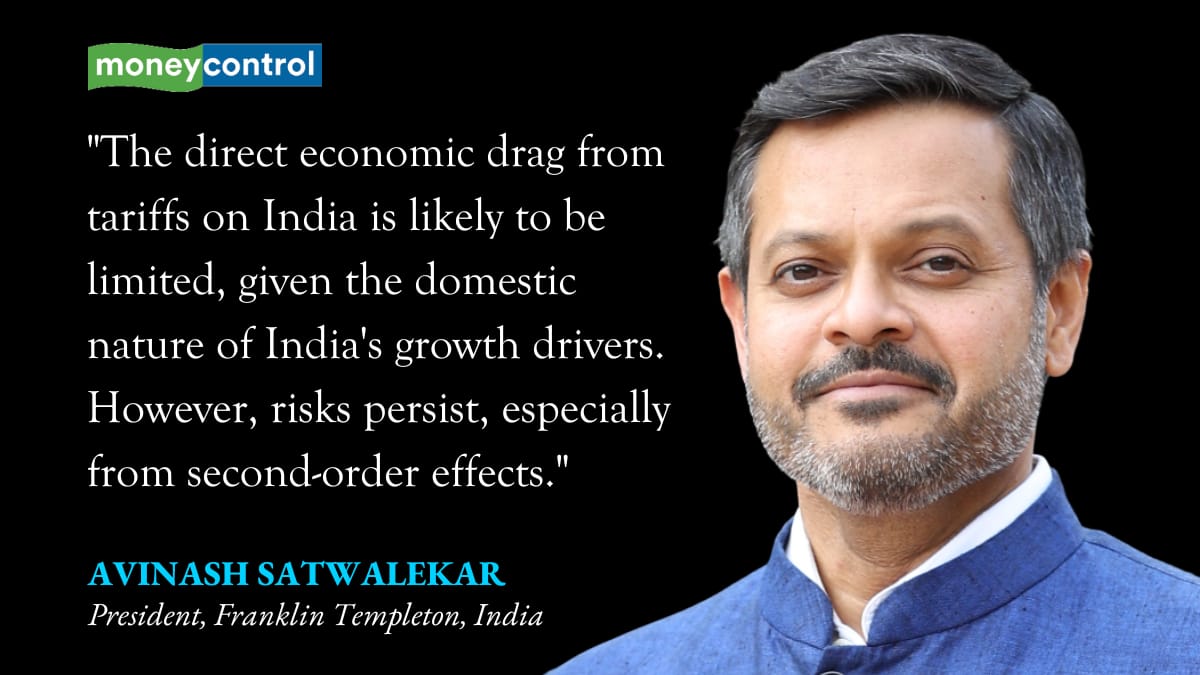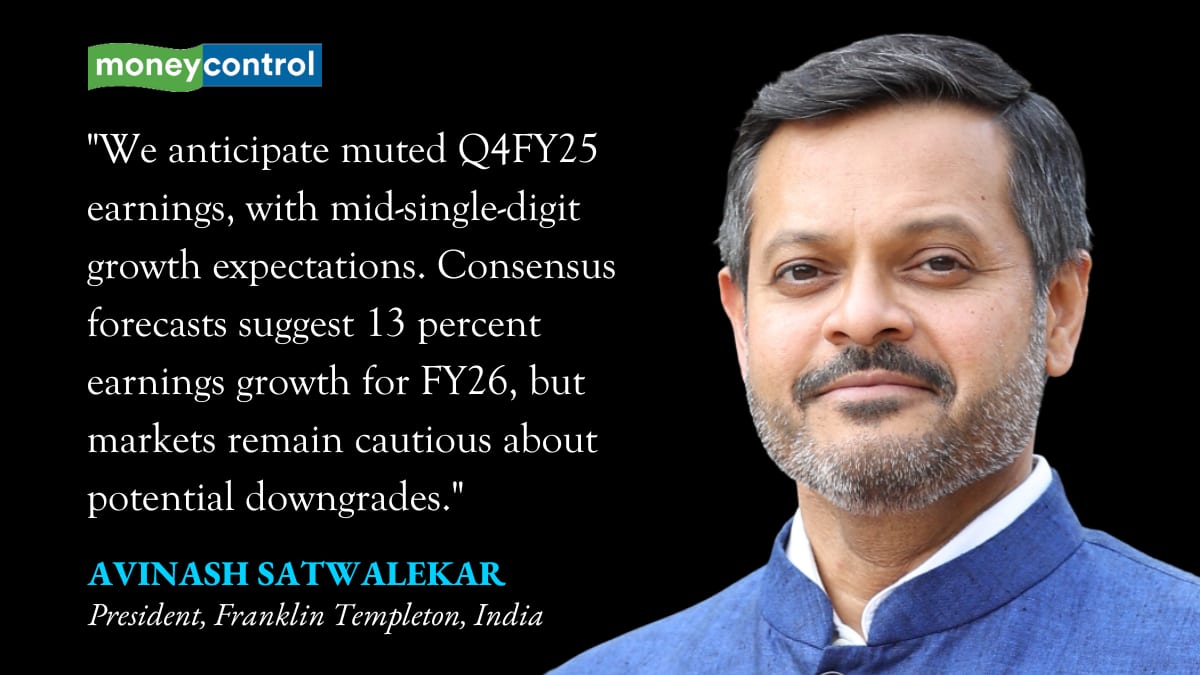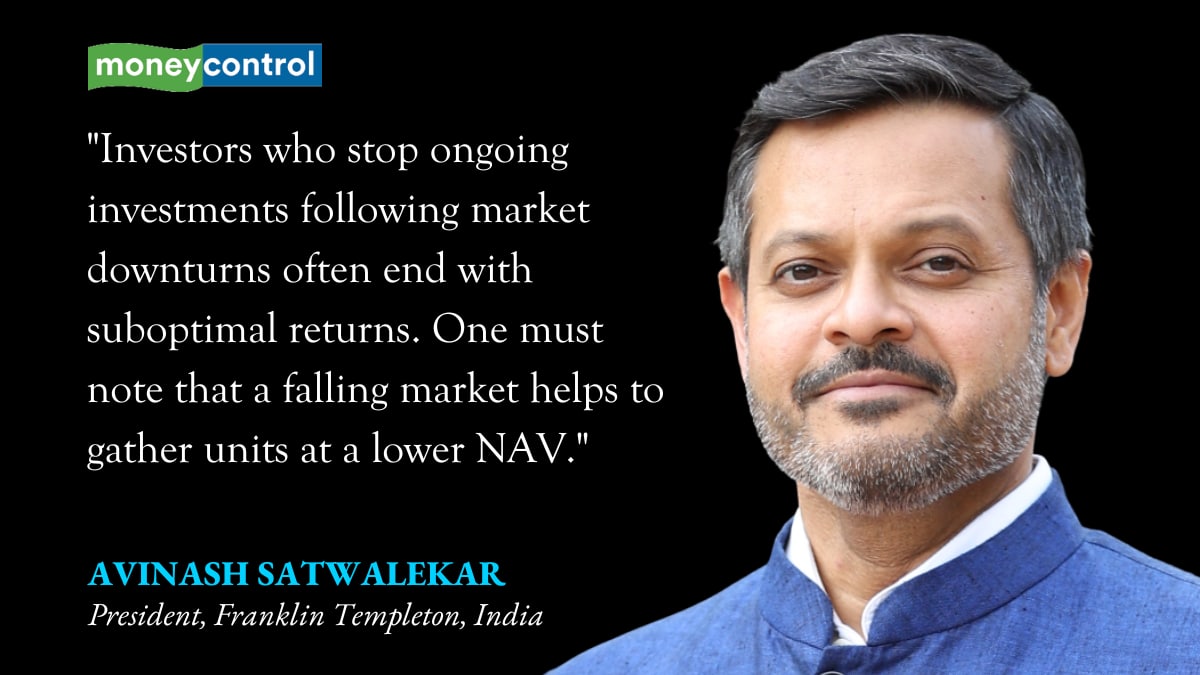



With the downward trajectory of inflation, the easing of monetary policy, improved credit availability and reductions in income tax, Avi Satwalekar, President, Franklin Templeton Asset Management (India) sees favourable growth prospects for the consumer discretionary sector in India.
He says that irrespective of the market scenario, it would be prudent for investors to take a staggered investment approach via SIPs rather than investing lumpsum in equity funds.
“For this, investors may park their corpus of Rs 10 lakh in a debt fund or a conservative hybrid fund and systematically transfer the money into diversified equity funds,” he says.
Also read | Where to invest Rs 10 lakh in this market? Ihab Dalwai of ICICI Prudential AMC answers
In an interview with Moneycontrol, Satwalekar talks about how the fund house is positioned in its equity fund given the current macroeconomic environment, key monitorables for markets and advice to investors.
Will the party continue in the Indian market?
The market until September 2024 was on a one-way trajectory, reaching its peaks. Indian markets experienced a decline for six consecutive months since September 2024 due to reduced government capital expenditure (capex), weak consumption, stretched valuations and currency pressures.
This cyclical growth slowdown, which impacted corporate earnings, represents a temporary phase within a longer-term growth cycle. Despite these challenges, the markets saw a recovery in March and April 2025. We expect the market to consolidate, given the lack of clarity on the global tariff fronts. Overall, we have a cautious near-term outlook for both global and domestic markets. However, our long-term outlook is positive for India.
What do you think is the most important monitorable for the market right now?
The global economic conditions have been hazy and are currently facing several challenges and uncertainties. One of the key factors influencing market movements is the impact of tariffs introduced by the US administration. Trade policy uncertainty, driven by recent tariff hikes, is expected to negatively impact global trade and growth at both macro and micro levels, as companies have kept capex on hold to gain more clarity.
While the US President has announced a 90-day pause on reciprocal tariffs, the base tariff of 10 percent will continue for all. The direct economic drag from tariffs on India is likely to be limited, given the domestic nature of India's growth drivers. However, risks persist, especially from second-order effects, which include uncertainty in the business climate impacting the revival of the private capex cycle. This, in turn, could weigh on economic growth, making the near-term volatile.

Let me also add that the recent agreement between the US and China to lower tariffs on each other is a key breakthrough on this impasse. Under the agreement, the US has reduced its tariffs on Chinese imports from a steep 145 percent to 30 percent, while China has reciprocated by slashing its tariffs from 125 percent to 10 percent. However, more developments on this front will be monitored closely.
How are FT's funds positioned given the current macroeconomic environment?
Franklin Templeton equity funds have a long-term orientation and are positioned to benefit from India’s growth story. Our portfolio construction approach focuses on identifying growth compounders – stocks that can provide healthy growth year after year for several years. Our funds endeavour to participate in sectors that show reasonable resilience to volatile market conditions and economic fluctuations. The current portfolio allocation aims to increase exposure to companies with larger domestic drivers.
Which sectors do you see as long-term structural bets for India?
With the inflation trend on the downside, monetary policy easing, availability of credit, and income tax cuts, we see positive growth prospects in consumer discretionary. We are overweight in the sector as we tend to find good compounding ideas and expect a recovery in lower and middle-income consumption.
Also read | What Virat Kohli’s Test career teaches us about winning in personal finance
We are also focused on the growth of the financial sector, which shows reasonable growth, attractive valuations, stable asset quality, and private banks gaining market share.
Export sectors such as electronics manufacturing services (EMS) are comparatively better off in India than their peers in China or Vietnam. Companies are looking to increase capex and build manufacturing capability to capture EMS play opportunities in India.
What is your take on the results that have come out from India Inc, and what are your expectations for the next few quarters?
GDP growth estimates for India have been downgraded by 30–50 basis points by various agencies, including the IMF.
We anticipate muted Q4FY25 earnings, with mid-single-digit growth expectations. Consensus forecasts suggest 13 percent earnings growth for FY26, but markets remain cautious about potential downgrades, similar to FY25.

Do you believe Indian investors are maturing in terms of investment behaviour, or is short-termism still a major challenge?
Yes, to a certain extent. There are more investors focusing on their long-term goals. A recent report published by AMFI highlights that SIP AUM held for more than 5 years has increased from 12 percent of total SIP AUM in 2019 to 21 percent in 2024. Further, SIP AUM held for less than 1 year was 46 percent in 2019, which reduced to 28 percent in 2024. These numbers indicate an improvement in the tenure of investments.
Further, gross monthly flows through SIPs continue to be steady at over Rs 25,000 crore while equity net sales are positive for 50 consecutive months – more than 4 years.
Also read | Buy, sell or hold: How should retail investors look at gold amid easing global tensions?
While the above signals point to investors looking at longer investment horizons, SIP stoppages, however, tend to rise during market volatility. The industry has witnessed SIP stoppage ratio of more than 100 percent over the last 4 consecutive months till April 2025.
While we see SIP tenures improving over the years, there remains scope to guide and handhold new investors who may have started their investing journey in recent years and may not have witnessed a market correction earlier.
What product innovation or category are you most excited about over the next 5 years?
The Securities and Exchange Board of India has recently introduced the framework for Specialised Investment Funds (SIFs), which fill the gap that existed between mutual funds and PMS. These funds have a relatively more flexible investment mandate to take higher risk exposures and have a minimum ticket size of Rs 10 lakh.
This new segment could see growth over the next few years and provide opportunities which are not available under the mutual funds umbrella.
Rather than a specific product category, I would say the mutual fund industry as a whole has good growth potential owing to rising disposable incomes and financialisation of savings. We have close to 5.5 crore investors versus 8 crore taxpayers and 19 crore demat accounts; our AUM to GDP ratio is 19 percent versus the world average of 74 percent, indicating the scope for growth of the industry.
How do you see AI and machine learning transforming asset management in India?
AI is potentially the most transformative technology since the internet was launched in the 90s. These technologies are great enablers to help the industry with predictive analytics on investor behaviour as well as for portfolio management activities. This will not just aid us in offering timely and customised investment solutions but will also help to spot investment opportunities in the early stages of the growth cycle.
On the global diversification front, most markets, including China, Europe and the US, are under pressure. Do you think India is the safest bet, or are there other geographies where investors should look to allocate a part of their portfolios?
Indian investors tend to have a home bias and park most of their investments in Indian securities. However, it is important not just to diversify across stocks, sectors and asset classes but also across geographies. Mutual funds help to provide diversification across all these parameters.
Also read | Beyond tuition fees: The real cost of studying abroad
If you look at markets like the US, it has some of the world’s largest companies that are not listed in India. It is also the world’s largest economy with a more than 25 percent share of global GDP, while India is just 4 percent of global GDP. On the other hand, the US is 50 percent of the global equity market cap versus 3 percent for India. It therefore merits inclusion in an investor’s portfolio via mutual funds.
Besides the US, one may look at other regions to diversify geographically as such diversification helps mitigate risks associated with any single market, besides taking advantage of growth opportunities across different regions.
One piece of advice to investors who look at major developments and market gyrations every single day?
Focus on your long-term goals and try to ignore the short-term moves in the market. Equity market moves in cycles. It is never a linear journey. Over the past 30 years, the Sensex has grown over 25 times at 11 percent CAGR till the end of April 2025. These 30 years have seen several periods of downcycles like the 2008 global financial crisis, the 2020 Covid crisis and the recent market decline in April following the announcement of tariffs by the US. The market has eventually recovered from each of these downcycles and moved higher. Remember that bear markets are measured in months whereas bull markets are measured in years. View market volatility as an opportunity to lower your long-term average cost.
Investors who stop their ongoing investments following market downturns often end with suboptimal returns. One must note that a falling market helps to gather units at a lower NAV. Multiple such cycles help to reduce the average cost of units over longer periods. Investors who remain patient across market cycles and focus on their long-term goals are likely to benefit from this power of compounding.

If someone has Rs 10 lakh to invest right now, what should be the asset allocation strategy?
Asset allocation is a long-term decision and should only be changed if your long-term goals change. Irrespective of the market scenario, it is prudent to take a staggered investment approach via SIPs rather than investing lumpsum in equity funds. For this, investors may park their corpus of Rs 10 lakh in a debt fund or a conservative hybrid fund and systematically transfer the money into diversified equity funds. This approach can help investors with a long-term investment horizon to reduce portfolio volatility associated with lumpsum investments in uncertain times.
Also read | Is travel insurance necessary for short trips?
Discover the latest Business News, Sensex, and Nifty updates. Obtain Personal Finance insights, tax queries, and expert opinions on Moneycontrol or download the Moneycontrol App to stay updated!